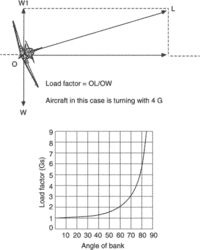load factor
[′lōd ‚fak·tər] (electricity)
The ratio of average electric load to peak load, usually calculated over a 1-hour period.
(mechanics)
The ratio of load to the maximum rated load.
McGraw-Hill Dictionary of Scientific & Technical Terms, 6E, Copyright © 2003 by The McGraw-Hill Companies, Inc.
load factor
1. In structural design, the factor by which a working load is multiplied to determine the design ultimate load.
2. In air conditioning, the ratio of the average load on a system to the maximum load capacity.
3. In plumbing, the percentage of the total flow rate (expressed in fixture units) which is likely to occur at any point in the drainage system; represents the ratio of the probable load to the potential load.
McGraw-Hill Dictionary of Architecture and Construction. Copyright © 2003 by McGraw-Hill Companies, Inc.
load factor
i. The ratio of a specified load to the total weight of the aircraft. The specified load is expressed in terms of aerodynamic forces or ground or water reaction. Aerodynamically, it is the ratio of the total lift to the weight. The load factor is generally referred to as g and in some calculations as n (the load factor g or n = total lift/weight). In level flight, the lift is equal to the weight and the load factor is 1. In the case of maneuvers, the load imposed on the aircraft leads to an increase in the lift and since the weight remains the same, the load factor, or g, increases. The amount of g application decides the tightness of the turn. The higher the g, the tighter the turn. The load factor = wing loading in a maneuver/wing loading in a straight and level flight. The load factor is measured by an accelerometer, which is also called a g-meter. The load factor also affects the stalling speed of an aircraft, which is equal to the product of the normal stalling speed and the square root of the applied g. See also g.
ii. The ratio of specified load to the total weight of the aircraft. The specified load is expressed in terms of aerodynamic forces, inertia forces, or ground or water reaction.
iii. The number of passenger seats occupied as a percentage of the total seats available.
iv. The revenue-ton mile/kilometers performed as a percentage of the revenue-ton mile/kilometers available.
ii. The ratio of specified load to the total weight of the aircraft. The specified load is expressed in terms of aerodynamic forces, inertia forces, or ground or water reaction.
iii. The number of passenger seats occupied as a percentage of the total seats available.
iv. The revenue-ton mile/kilometers performed as a percentage of the revenue-ton mile/kilometers available.
An Illustrated Dictionary of Aviation Copyright © 2005 by The McGraw-Hill Companies, Inc. All rights reserved
